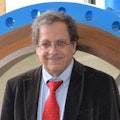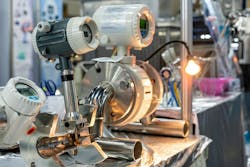Key Highlights
- Vortex flowmeters are highly versatile, capable of accurately measuring liquids, gases, and steam.
- Major global suppliers include Emerson, Endress+Hauser, Krohne and Yokogawa
Vortex flowmeters are known for their versatility and ability to measuring steam flow. They are one of a handful of meters that can measure liquids, gas and steam with equal ease. Leading vortex suppliers in alphabetical order include Emerson, Endress+Hauser, Krohne and Yokogawa.
How they work
Vortex flowmeters operate on a principle called the von Karman effect. This principle concerns the behavior of fluids when an obstacle is placed in the path of flow. Under the right conditions, the presence of the obstacle generates a series of alternative vortices called the von Karman street. This phenomenon occurs in liquid, gas and steam, and has been observed in many diverse contexts including cloud layers passing an island and whitewater rapids.
In vortex flowmeters, the obstacle takes the form of an object with a broad, flat front called a bluff body that is mounted at right angles to the flow stream. Flow velocity is proportional to the frequency of the vortices, and the flowrate is calculated by multiplying the area of the pipe times the velocity of the flow.
To compute the flowrate, vortex flowmeters count the number of vortices generated by the bluff body using a variety of techniques. Most vortex flowmeters use a piezoelectric sensor to detect vortices; however, some use a capacitive or ultrasonic sensor.
How Coriolis flowmeters developed
The question of who first successfully commercialized vortex flowmeters is a fascinating story, and in many ways, it parallels the development of Coriolis flowmeters. As was the case with Coriolis flowmeters, there was a series of early patents that laid the groundwork for later developments. Eventually, one or two companies came along to build on these early patents and failed attempts and brought the flowmeter into commercial production.
In the case of Coriolis meters, some notable efforts include patents by Roby White (1958), Yao Tzu Li (1960) and Anatole Sipin (1965) that were some of the most pivotal. White and Li proposed rotating the fluid, while Sipin suggested oscillating the flow tube containing the fluid. In 1975, Jim Smith built on Sipin’s oscillation idea and applied for a patent that oscillated the flow tube rather than rotating it. In 1977, he formed Micro Motion out of his garage, and in 1979 introduced the first Micro Motion Coriolis flowmeter. Emerson bought Micro Motion in 1984 and has been the dominant force in Coriolis flowmeters ever since.
The history of how vortex meters came to be is a little more complicated than the Coriolis story, partly because it played out in both the U.S. and Japan. It is similar in that it occurred at almost the same time as the development of Coriolis meters. While some articles and patents relating to vortex appeared in the 1950s and 1960s, the most serious early work on vortex flowmeters occurred in the late 1960s and early 1970s, and it involves Eastech and Yokogawa.
Eastech
Eastech was organized as a New Jersey corporation in February 1968. In February 1969, Eastech became a Delaware corporation whose officers were Dr. Douglas F. White,
Alan E. Rodely and Charles McMurtrie. Alan E. Rodely received a German vortex patent in 1968, but it didn’t apply in the U.S. In 1969, he applied in the United States for another vortex patent that was granted in 1971. Also in 1971, Rodely received another patent for a differential sensor bluff body flowmeter with Charles McMurtrie. Then in 1973, Theodore Fussell received a patent for a bluff body flowmeter with an internal sensor.
Get your subscription to Control's tri-weekly newsletter.
All the above patents by Rodely and Fussell were assigned to Eastech Inc., so Eastech was in operation then. What is not clear is the extent to which Eastech commercialized the products described in these patents during this time. However, in 1976, Eastech was sold to Neptune Meter and began operating as Neptune Eastech. At this point, Douglas White retired as president, and was succeeded by Douglas Brooks, who served until he retired in 1979.
The company continued operating as Neptune Eastech for many years until it was purchased and rebranded as Eastech Vortex. In 2000, Frank Sinclair bought Eastech Vortex from two men who had bought it from Neptune Meter and retired the vortex product line in 2001. At the same time, Frank Sinclair acquired the ultrasonic product line from Badger Meter in 2000 and changed the company name to Eastech Flow Controls.
Yokogawa
In the meantime, Yokogawa developed its own vortex flowmeter and introduced it in 1969. The development of Yokogawa’s vortex meter mostly occurred in Japan and was in part based on university and academic publications. However, there is some evidence that Yokogawa’s developers were aware in the 1970s of the Eastech patents. In 1969, Yokogawa came out with its own insertion vortex meter for flare stacks.
It seems clear that Yokogawa was first to market with an insertion vortex flowmeter. However, they may not have been the first to market an inline vortex meter. Before commercializing Yewflo, Yokogawa conducted research and performed various experiments. Yokogawa’s Yewflo line, which included inline meters, came out in 1979. The patents attributed to Eastech Inc. in the early 1970s were for inline meters. However, it is not clear to what extent Eastech or Neptune Eastech commercialized the meters described in their patents. If they did this successfully before 1979, they may have been the first to bring an inline vortex meter to market. Another possibility is that, while Yokogawa released its YEWFLO line in 1979, they may have sold some inline meters before that release. While this is possible, Yokogawa was indisputably first to the vortex market with its insertion vortex meter.
The following graphic shows the development of Yokogawa’s vortex flowmeters from 1969 to 2022. In 2022, the company brought out a new line of vortex flowmeters called the VY Series.
About the Author

Jesse Yoder
Columnist
Jesse Yoder is founder and president of Flow Research Inc., which conducts market research studies in a wide variety of areas, including the flowmeter market.

Leaders relevant to this article:

